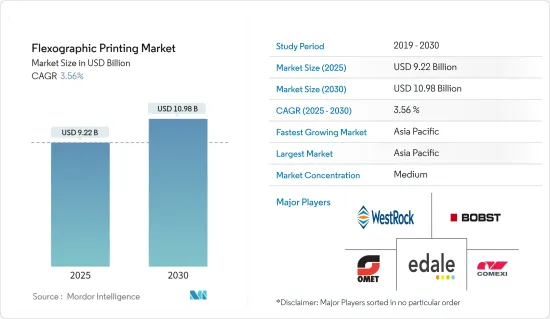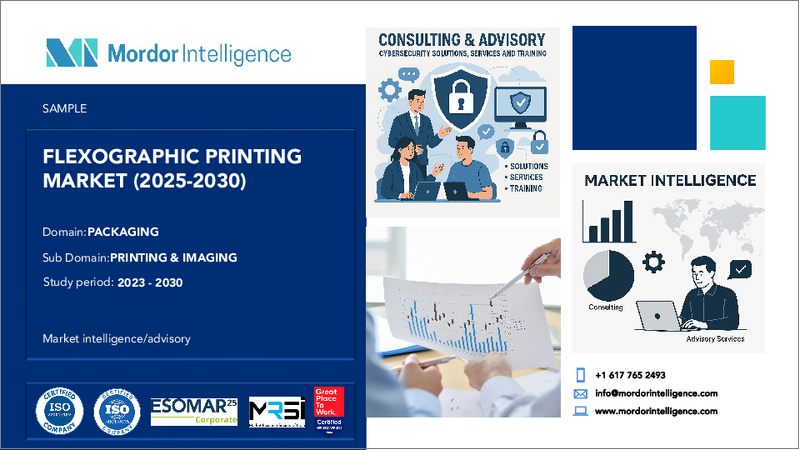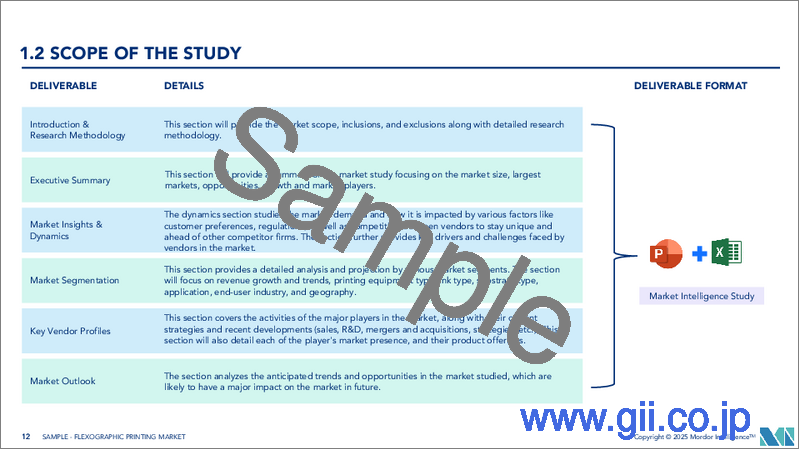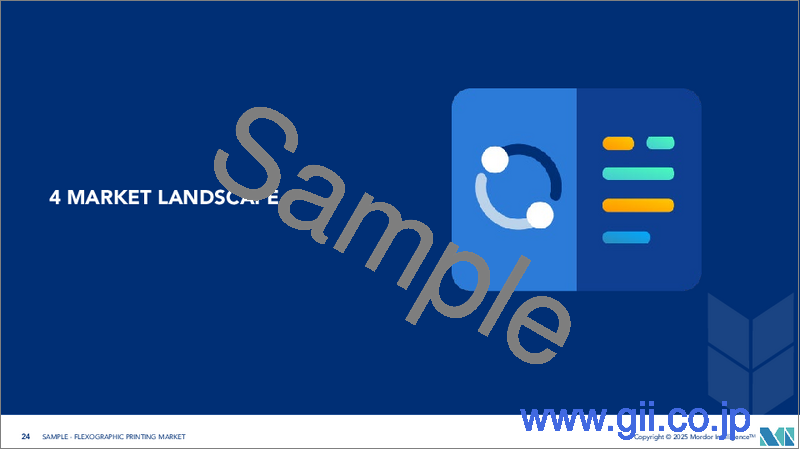|
|
市場調査レポート
商品コード
1642211
フレキソ印刷:市場シェア分析、産業動向と統計、成長予測(2025~2030年)Flexographic Printing - Market Share Analysis, Industry Trends & Statistics, Growth Forecasts (2025 - 2030) |
||||||
カスタマイズ可能
適宜更新あり
|
|||||||
| フレキソ印刷:市場シェア分析、産業動向と統計、成長予測(2025~2030年) |
|
出版日: 2025年01月05日
発行: Mordor Intelligence
ページ情報: 英文 110 Pages
納期: 2~3営業日
|
全表示
- 概要
- 目次
フレキソ印刷市場規模は2025年に92億2,000万米ドルと推定され、予測期間(2025~2030年)のCAGRは3.56%で、2030年には109億8,000万米ドルに達すると予測されます。

フレキソ印刷は包装産業で大きな注目を集めており、ラベル、カートン、軟質プラスチックの印刷に応用されています。同市場は、飲食品のような産業の成長から恩恵を受ける態勢が整っています。
主要ハイライト
- フレキソ印刷は、最も急成長している印刷プロセスの1つです。多様な基材への印刷が可能な汎用性により、その有用性は様々な製品に広がっています。技術の進歩はフレキソ印刷市場をますます形成しています。
- 高い生産速度と効率的な印刷への需要がフレキソ印刷市場を牽引しています。フレキソ印刷の進歩に伴い、インキの市場も広がっています。特に食品や消費財のセグメントで包装への印刷の動向が高まり、フレキソ印刷の採用が急速に進んでいます。
- フレキソ印刷には、鮮やかな色彩と鮮明な画像を備えた高品質の印刷物を提供できるという、極めて重要な利点があります。これは、フレキソ印刷特有の版によるインキ転移の正確さによって達成されます。さらに、これらの印刷機は色見当合わせに優れており、印刷全体にわたって一貫性が保証されます。
- フレキソ印刷は需要が急増しているが、その主要理由は代替品と比較して費用対効果が高いことです。この効率性は、特に他のシステムと統合した場合に、生産速度が速く、速乾性インキとの互換性があることに起因しています。フレキソ印刷の需要を後押ししているのは、小ロットで迅速な出力に対する意欲の高まりに後押しされたeコマースセグメントです。フレキソ印刷は、段ボールからラベル、金属フィルムに至るまで、さまざまな材料の印刷に適した方法です。
- 歴史的に労働力に依存してきた印刷産業では、離職率と雇用動向には密接な相関関係があった。しかし、機械設計やデジタル化などの進歩が生産性を高め、直接雇用から成長を切り離しました。こうした躍進にもかかわらず、原料費の高騰が市場参入企業を制約しています。フレキソ印刷で重要な材料には、紙、インク、印刷材料、各種化学品が含まれます。
フレキソ印刷市場の動向
折りたたみカートンが大きなシェアを占める見込み
- フレキソ印刷は、速乾性と無害なインクの使用で知られ、食品包装に好まれています。牛乳パック、飲食品容器、使い捨てカップへの印刷が主要用途です。
- 折りたたみカートンは軽量であるため、世界的に需要が高まっています。物理的なカートンと最終的な印刷の両方で品質を確保することが最も重要です。この需要に対応するため、印刷会社は多拠点オペレーションを採用するようになってきています。注目すべきは、食糧農業機構(Food and Agriculture Organization)の予測によると、カートンボードの生産量は2022年の1万1,796トンからわずかに増加し、2024年には1万1,993トンに達すると予想されていることです。
- 消費者のライフスタイルや食習慣の変化が、特に食品を中心とした包装製品の需要急増を後押ししています。この動向は紙器用フレキソ印刷市場に大きな影響を与えています。保存性の向上、消費者の安全性、人口増加に伴う一人当たりの可処分所得の増加といった要因が、この需要をさらに後押ししています。
- かつては、カッター・クリーズやプラテン型抜き作業は、主にグラビア印刷機や枚葉オフセット印刷機に関連するもので、紙器印刷機に関連するものではありません。しかし、フレキソ印刷の品質が向上し、水性インキやUVインキが採用され、設備コストが削減されたことで、コンバーターは高品質の紙器用としてフレキソ印刷にますます目を向けるようになっています。
- フレキソ印刷には紙器印刷の歴史があるが、最近、この目的に中央インプレッション印刷機を使用するようになったことは注目に値します。当初、フレキソ印刷は主にピザカートンのような製品に使用されていました。しかし、ワイドウェブ上で正確な見当合わせを行いながら多色印刷を実現できるようになったことで、特に購買時点の紙器用途でその魅力が広がっています。
アジア太平洋がフレキソ印刷市場を独占する見込み
- 同地域のeコマース産業は急成長を遂げており、これがフレキソ印刷導入拡大の主要要因となっています。フレキソ印刷はラベルの製造に極めて重要であり、特に段ボールへの印刷に広く利用されています。例えば、Invest Indiaはeコマース市場が2030年までに3,500億米ドルに急増すると予測しています。
- 包装と印刷ラベルの重要な消費者である急成長中の物流部門は、フレキソ印刷市場を推進する態勢を整えています。さらに、地域政府が製造業を強化する取り組みを強化しているため、フレキソ印刷の需要もそれに伴って増加すると予想されます。
- フレキソ印刷市場はある程度成熟しているが、産業は現在と将来の顧客の需要に対応するため、重要な技術革新と用途を確認し続けています。出版物から包装への絶え間ない移行と印刷技術の進歩に後押しされ、市場は成長する態勢を整えています。さらに、主要な市場参入企業は、この地域に参入し、市場でのプレゼンスを拡大するために、戦略的イノベーションやパートナーシップを結んでいます。これらの提携は、今後数年間、この地域に製品提供を導入し、フレキソ印刷の採用を促進すると考えられます。
- この地域で事業を展開する企業は、イノベーションを通じて事業を拡大しています。例えば、2024年3月、インドのアーメダバードを拠点とするFlexure Print N Packは、冷凍食品クライアントの商業印刷を完了し、マイルストーンを達成しました。Echaar FlexoSmart HR300セントラル・インプレッション・フレキソ印刷を使用して、208本/インチ(LPI)という卓越した印刷解像度を達成し、フレキソ印刷技術の顕著な飛躍を示しました。
- アジア太平洋は世界の商業印刷市場を独占しており、中国、インド、日本、インドネシア、タイ、ベトナムなどの新興国における商業印刷の消費の増加により、今後数年間も同様の成長が見込まれています。
フレキソ印刷産業概要
本調査では、様々な市場ベンダーが提供するフレキソ印刷サービスの売上高を考察しています。さらに、消費者支出、嗜好動向、供給力学、その他のマクロ経済要因などの複数の要因を考慮し、市場全体と将来の成長予測を導き出します。
フレキソ印刷市場はセグメント化されており、Amcor PLC、Westrock Company、Sonoco Products Company、Bobst Group SAなどの企業があります。市場シェアの面では、現在数社の大手企業が市場を独占しています。大きな市場シェアを持つこれらの大手企業は、他国への顧客基盤の拡大を目指しています。これらの企業は、市場シェアを拡大し収益性を高めるために、戦略的な共同イニシアティブを活用しています。
その他の特典
- エクセル形式の市場予測(ME)シート
- 3ヶ月間のアナリストサポート
目次
第1章 イントロダクション
- 調査想定と市場定義
- 調査範囲
第2章 調査手法
第3章 エグゼクティブサマリー
第4章 市場洞察
- 市場概要
- 産業の魅力-ポーターのファイブフォース分析
- 供給企業の交渉力
- 買い手の交渉力
- 新規参入業者の脅威
- 代替品の脅威
- 競争企業間の敵対関係の強さ
- 産業バリューチェーン分析
第5章 市場力学
- 市場促進要因
- 印刷コストの削減
- 技術の進歩と印刷品質の向上
- 市場抑制要因
- 新しい印刷技術の出現
第6章 フレキソ印刷の市場情勢
- ナローウェブ
- ミディアムウェブ
- シートフェッド
- その他の印刷機器
第7章 市場セグメンテーション
- 用途別
- 段ボール箱
- 折りたたみカートン
- 軟包装
- ラベル
- 印刷メディア
- その他
- 地域別
- 北米
- 米国
- カナダ
- 欧州
- 英国
- ドイツ
- フランス
- イタリア
- スペイン
- アジア太平洋
- 中国
- インド
- 日本
- オーストラリア・ニュージーランド
- ラテンアメリカ
- 中東・アフリカ
- 北米
第8章 競合情勢
- 企業プロファイル
- InterFlex Group
- Pepin Manufacturing Inc.
- Siva Group
- Flexopack SA
- Wolverine Flexographic LLC(Crosson Holdings LLC)
- Bobst Group SA
- Edale UK Limited
- Heidelberger Druckmaschinen AG
- OMET SRL
- Star Flex International
- Comexi Group
第9章 投資分析
第10章 市場の将来
The Flexographic Printing Market size is estimated at USD 9.22 billion in 2025, and is expected to reach USD 10.98 billion by 2030, at a CAGR of 3.56% during the forecast period (2025-2030).

Flexographic printing has garnered substantial attention in the packaging industry, finding applications in printing labels, cartons, and flexible plastics. The market is poised to benefit from the growth in industries like food and beverages.
Key Highlights
- Flexographic printing has emerged as one of the swiftest-growing print processes. Its versatility in printing on diverse substrates has expanded its utility to various products. Technological advancements are increasingly shaping the flexographic printing machine market.
- The demand for high production speeds and efficient printing drives the flexographic printing machine market. As flexographic printing advances, it opens up a broad market for inks. The rising trend of printing on packaging, particularly in the food and consumer goods sectors, is fast-tracking the adoption of flexographic printing equipment.
- Flexographic printing presses offer a crucial advantage: the capability to deliver high-quality prints with vibrant colors and sharp images. This is achieved through the precision of ink transfer facilitated by the plates unique to flexographic printing. Furthermore, these presses excel in color registration, guaranteeing consistency across the printing run.
- Flexographic printing machines are witnessing a surge in demand, primarily due to their cost-effectiveness compared to alternatives. This efficiency is attributed to their quicker production rates and compatibility with fast-drying inks, especially when integrated with other systems. The e-commerce sectors, driven by a rising appetite for short-run, swift outputs, fuel the demand for flexographic printing. Flexography is the go-to method for printing materials ranging from corrugated cardboard to labels and metallic films.
- Historically reliant on labor, the printing industry saw a close correlation between turnover and employment trends. However, advancements like machinery design and digitalization have boosted productivity, decoupling growth from direct employment. Despite these strides, escalating raw material costs have constrained market players. Critical materials in flexographic printing encompass paper, ink, printing materials, and various chemicals.
Flexographic Printing Market Trends
Folding Cartons Expected to Account for a Significant Share
- Flexographic printing, known for its quick-drying properties and use of non-toxic inks, is a favored choice for food packaging. It finds primary applications in printing on milk cartons, food and beverage containers, and disposable cups.
- Global demand for folding cartons is rising due to their lightweight nature. Ensuring quality in both the physical carton and the final print is paramount. To keep up with this demand, printers are increasingly adopting multi-site operations. Notably, the Food and Agriculture Organization projects a slight uptick in carton board production, from 11,796 metric tons in 2022, and it is expected to reach 11,993 metric tons in 2024.
- Changing consumer lifestyles and eating habits are fueling a surge in demand for packaged products, especially in food. This trend is significantly impacting the flexographic printing market for folding cartons. Factors such as enhanced shelf life, consumer safety, and the increasing per capita disposable income, alongside a growing population, further bolstered this demand.
- In the past, cutter-crease or platen die-cutting operations were predominantly associated with rotogravure or sheet-fed offset presses, not folding carton presses. However, with advancements in flexographic printing quality, water-based or UV ink adoption, and reduced equipment costs, converters are increasingly turning to flexographic printing for high-quality folding cartons.
- While flexographic printing has a history of printing folding cartons, the recent shift towards using central impression presses for this purpose is notable. Initially, flexo printing was primarily used for products like pizza cartons. However, the capability to achieve multi-color prints with precise registration on the wide web has broadened its appeal, especially for point-of-purchase folding carton applications.
Asia-Pacific Expected to Dominate the Flexographic Printing Market
- The e-commerce industry in the region is witnessing rapid growth, which is a key driver behind the increasing adoption of flexographic printing machines. Flexographic printing is pivotal for producing labels and is extensively utilized, especially in printing on corrugated cardboard. For instance, Invest India projects the e-commerce market to surge to USD 350 billion by 2030.
- The burgeoning logistics sector, a significant consumer of packaging and printed labels, is poised to propel the flexographic printing market. Furthermore, as regional governments intensify efforts to bolster the manufacturing sector, the demand for flexographic printing machines is expected to rise correspondingly.
- Despite the flexographic printing market achieving a degree of maturity, the industry continues to witness significant technological innovations and applications, addressing present and future client demands. Driven by a persistent transition from publications to packaging and advancements in printing technologies, the market is poised for growth. Moreover, key market players are forging strategic innovations or partnerships to enter the region and expand their market presence. These collaborations will introduce the area to product offerings and drive the adoption of flexographic printing machines in the coming years.
- Companies operating in the region are growing their business through innovations. For instance, in March 2024, Flexure Print N Pack, based in Ahmedabad, India, achieved a milestone by completing a commercial print run for a frozen food client. It achieved an exceptional print resolution of 208 lines per Inch (LPI) using the Echaar FlexoSmart HR300 central impression flexographic printing press, showcasing a notable leap in flexographic printing technology.
- Asia-Pacific is dominating the global commercial printing market and is expected to witness similar growth over the coming years owing to the increasing consumption of commercial printing in emerging economies such as China, India, Japan, Indonesia, Thailand, and Vietnam.
Flexographic Printing Industry Overview
The study considers revenues from the sales of flexographic printing services offered by various market vendors. Further, multiple factors, such as consumer spending, preference trends, supply dynamics, and other macroeconomic factors, are considered to arrive at the overall market and future growth projections.
The flexographic printing market is fragmented, with several companies such as Amcor PLC, Westrock Company, Sonoco Products Company, and Bobst Group SA. In terms of market share, few of the major players currently dominate the market. With a significant market share, these major players aim to expand their customer base across other countries. These companies leverage strategic collaborative initiatives to augment their market share and increase profitability.
Additional Benefits:
- The market estimate (ME) sheet in Excel format
- 3 months of analyst support
TABLE OF CONTENTS
1 INTRODUCTION
- 1.1 Study Assumption and Market Definition
- 1.2 Scope of the Study
2 RESEARCH METHODOLOGY
3 EXECUTIVE SUMMARY
4 MARKET INSIGHTS
- 4.1 Market Overview
- 4.2 Industry Attractiveness - Porter's Five Forces Analysis
- 4.2.1 Bargaining Power of Suppliers
- 4.2.2 Bargaining Power of Buyers
- 4.2.3 Threat of New Entrants
- 4.2.4 Threat of Substitute Products
- 4.2.5 Intensity of Competitive Rivalry
- 4.3 Industry Value Chain Analysis
5 MARKET DYNAMICS
- 5.1 Market Drivers
- 5.1.1 Reduced Printing Costs
- 5.1.2 Technological Advancements and Improved Print Quality
- 5.2 Market Restraints
- 5.2.1 Advent of New Printing Technologies
6 FLEXOGRAPHIC PRINT EQUIPMENT MARKET LANDSCAPE
- 6.1 Narrow Web
- 6.2 Medium Web
- 6.3 Sheet Fed
- 6.4 Other Printing Equipment
7 MARKET SEGMENTATION
- 7.1 By Application
- 7.1.1 Corrugated Boxes
- 7.1.2 Folding Carton
- 7.1.3 Flexible Packaging
- 7.1.4 Labels
- 7.1.5 Print Media
- 7.1.6 Other Applications
- 7.2 By Geography
- 7.2.1 North America
- 7.2.1.1 United States
- 7.2.1.2 Canada
- 7.2.2 Europe
- 7.2.2.1 United Kingdom
- 7.2.2.2 Germany
- 7.2.2.3 France
- 7.2.2.4 Italy
- 7.2.2.5 Spain
- 7.2.3 Asia-Pacific
- 7.2.3.1 China
- 7.2.3.2 India
- 7.2.3.3 Japan
- 7.2.3.4 Australia and New Zealand
- 7.2.4 Latin America
- 7.2.5 Middle East and Africa
- 7.2.1 North America
8 COMPETITIVE LANDSCAPE
- 8.1 Company Profiles
- 8.1.1 InterFlex Group
- 8.1.2 Pepin Manufacturing Inc.
- 8.1.3 Siva Group
- 8.1.4 Flexopack SA
- 8.1.5 Wolverine Flexographic LLC (Crosson Holdings LLC)
- 8.1.6 Bobst Group SA
- 8.1.7 Edale UK Limited
- 8.1.8 Heidelberger Druckmaschinen AG
- 8.1.9 OMET SRL
- 8.1.10 Star Flex International
- 8.1.11 Comexi Group






